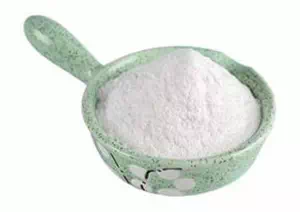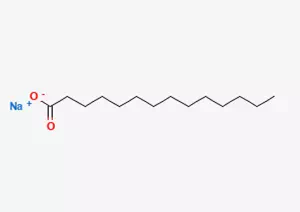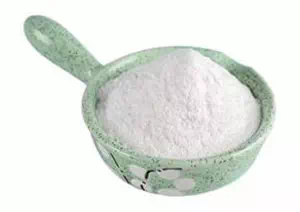All Categories



sodium myristate CAS 822-12-8, sodium myristate, CAS 822-12-8
In the current era of rapid development of science and technology, sodium myristic acid, a unique compound, has attracted extensive attention from many scientific researchers in the fields of materials science and biochemistry, and has received in-depth and extensive research.
CAS : 822-12-8
Formula : C14H27NaO2
Mol. wt. : 250.35
EINECS : 212-487-9
Chemical Name | Sodium Myristate |
Other Name | Sodium tetradecanoate |
CAS | 822-12-8 |
EINECS | 212-487-9 |
Type | Organic raw materials |
Molecular Formula | C14H27NaO2 |
Molecular Weight | 250.35 |
Melting point | 330 °C |
storage temp. | 2-8°C |
solubility | almost transparency in hot EtOH50vol% |
form | powder to crystal |
color | White to Almost white |

In the current era of rapid development of science and technology, sodium myristic acid, a unique compound, has attracted extensive attention from many scientific researchers in the fields of materials science and biochemistry, and has received in-depth and extensive research.
In the field of materials science, sodium myristic acid has demonstrated many characteristics worthy of exploration due to its unique chemical properties. As an important surfactant, it plays a key role in the construction and modification of various material systems. For instance, during the research and development of some new composite materials, sodium myristic acid can effectively interact with other material components through its unique molecular structure, thereby improving key indicators such as the surface properties, mechanical properties and stability of the materials.
In the field of biochemistry, the significance of sodium myristic acid is self-evident. Especially in the process of the formation of micelles and lipid bilayer, it plays an indispensable role. The formation of micelles is a complex and ordered process. The molecular structure of sodium myristic acid enables it to spontaneously aggregate to form a micelle structure in the solution. This micelle structure not only has a specific size and shape, but also can provide a relatively stable microenvironment for hydrophobic substances, thereby achieving functions such as solubilization and transportation of hydrophobic substances. Similarly, sodium myristic acid can also be involved in the formation of lipid bilayers, influencing the arrangement and organization of lipid molecules, and thereby altering the physicochemical properties of lipid bilayers.
This compound is absolutely indispensable for in-depth research on the properties of cell membranes and the mechanisms of action of soaps and detergents. As an important component of cells, the study of the structure and function of cell membranes is crucial for understanding the fundamental principles of life activities. Sodium myristic acid has a similar chemical structure to the lipid components in cell membranes, and thus can be used as a model compound to simulate the behavior of cell membranes. By studying the role of sodium myristic acid in the formation of micelles and lipid bilayers, scientists can gain a deeper understanding of the composition and structure of cell membranes and their impact on physiological processes such as substance transport and signal transduction.
Sodium myristic acid also plays an important role in the research on the mechanism of action of soaps and detergents. The main function of soap and detergent is to remove stains, and this process involves the interaction between surfactants and hydrophobic substances such as oil stains. Sodium myristic acid, as a typical surfactant, its interaction mode and effect with hydrophobic substances under different conditions provide an important theoretical basis for revealing the decontamination principles of soaps and detergents.
Scientists have made full use of these properties of sodium myristic acid to conduct in-depth research on how surfactants interact with biofilms. Biofilms are important interfaces for the exchange of substances and information transmission between cells and the external environment. The interaction between surfactants and biofilms involves many key cellular processes, such as chemical transport and toxin removal. For instance, in the process of studying the transmembrane transport of drugs, scientists can understand how drug molecules pass through the cell membrane and enter the cell interior by observing the interaction between sodium myristic acid and biological membranes. This is of great significance for the development of new drug delivery systems. Meanwhile, in terms of toxin removal, studying the interaction between surfactants and biofilms can help us better understand how cells recognize and eliminate harmful substances from the outside world, providing theoretical support for fields such as environmental protection and disease treatment.
In addition, the unique role of sodium myristic acid in micelle formation makes it have extremely high application value in research aimed at improving the solubilization efficiency of hydrophobic compounds. In many practical application scenarios, such as drug preparations and cosmetic research and development, the solubilization of hydrophobic compounds is a key issue that urgently needs to be addressed. Sodium myristic acid can enhance its solubility and stability in water by forming micellar structures and encapsulating hydrophobic compounds within them. Through in-depth research on the formation mechanism of sodium myristic acid micelles, scientists have explored how to optimize the structure and performance of micelles to achieve more efficient solubilization of hydrophobic compounds, providing important technical means for the development of related fields.

In the wonderful world of biochemistry, sodium myristic acid plays a crucial role, especially in the physiological processes related to rescue protein 1, where it undertakes the key task of achieving the N-myristic acylation of rescue protein 1.
Specifically, sodium myristoate is the sodium salt of myristoic acid. From the perspective of chemical structure, this specific form of sodium salt endows it with unique physicochemical properties. Among numerous application fields, sodium myristic acid has demonstrated diverse functions. It is often used as an adhesive. With its special molecular structure and chemical properties, it can effectively bond different substances closely together, ensuring that they remain in a stable composite state under various conditions. It plays an indispensable bonding role in food processing, the pharmaceutical industry, and other related fields.
Meanwhile, sodium myristic acid is also an excellent emulsifier. In an oil-water mixed system, it can reduce the surface tension at the oil-water interface, enabling the two originally immiscible liquids, oil and water, to be evenly mixed together to form a stable emulsion. This emulsification effect not only helps improve the texture and taste of products in the food industry, but also has wide applications in the fields of cosmetics and medicine, ensuring the uniform distribution of various components and enhancing the stability and effectiveness of the products.
In addition, sodium myristic acid also plays an important role as an anti-caking agent. In some powdered or granular substances, it can prevent the agglomeration and caking between particles due to various physical or chemical actions. By forming a protective film on the surface of the particles or changing the charge distribution on the particle surface, sodium mynutate effectively maintains the loose state of the substance, facilitating storage, transportation and use. This is of great significance for the quality control of many industrial production and daily necessities.
* Prompt reply and 24 hours online, professional team to provide best price and high quality product.
* Sample testing support.
* Every batch of products will be tested to ensureits quality.
*The packing also can be according the customers` requirment.
*Any inquiries will be replied within 24 hours.
*we provide Commerical Invoice, Packing List, Bill of loading, COA , Health certificate and Origin certificate. If your markets have any special requirements, let us know.